海流发电系统发展现状
海流能发电在南美洲国家能源供应中的应用

海流能发电在南美洲国家能源供应中的应用引言:随着全球对可再生能源的关注不断增加,海流能发电作为一种新兴的清洁能源形式,正在受到越来越多南美洲国家的关注。
南美洲拥有丰富的海洋资源和辽阔的海域,这为海流能发电提供了良好的条件。
本文将探讨海流能发电在南美洲国家能源供应中的应用,并总结利用海流能发电的优势和面临的挑战。
一、南美洲的海流能发电潜力南美洲作为一个拥有大量海洋资源的大陆,拥有广阔的海域和丰富的海流能发电潜力。
根据研究,南美洲的海流能资源主要分布在巴西、阿根廷、智利、秘鲁等沿海国家。
其中,巴西的北大西洋海流是南美洲最具潜力的海流能发电区域之一,智利的太平洋海流也具有较大的潜力。
二、海流能发电的优势1. 可再生性:海流能是一种不会枯竭的可再生能源,与传统能源相比,具有更长久的持续供应。
2. 清洁性:海流能发电过程中没有直接的二氧化碳排放,对环境几乎没有负面影响,使其成为一种环保的发电方式。
3. 稳定性:相比于风能和太阳能等不稳定的可再生能源,海流能发电具有更高的可预测性和稳定性,能够满足南美洲国家对稳定能源供应的需求。
4. 潜力巨大:南美洲拥有大量海洋资源和辽阔的海域,使得海流能发电在这个地区有着巨大的潜力。
三、南美洲国家海流能发电的现状与应用1. 巴西:巴西位于大西洋沿岸,拥有丰富的海流资源。
近年来,巴西积极推动海流能发电项目的开展。
例如,巴西北部巴利亚州已经开展了大规模的海流能发电试点项目,并取得了一定的成果。
此外,巴西还与国际合作伙伴合作,共同开展海流能发电技术的研究与发展。
2. 阿根廷:阿根廷拥有南美最长的海岸线,具有丰富的海流能资源。
尽管阿根廷在海流能发电方面的应用相对较少,但该国政府已经开始关注海流能发电的潜力,并制定了相关政策和法规,以吸引国内外投资者参与海流能发电项目。
3. 智利:智利拥有3200多公里的海岸线,位于太平洋东岸。
该国海流能发电潜力巨大,并且与海洋资源相关的电力技术已经发展成熟。
海洋能发展现状

海洋能发展现状
海洋能是一种可再生能源,包括潮汐能、波浪能和海流能等形式。
随着全球对可持续发展的需求不断增长,海洋能正逐渐成为能源行业的关注焦点。
潮汐能是海洋能中最成熟的形式之一。
通过利用潮汐的涨落,可以产生电力。
这一技术已经在一些地区得到应用,例如英国的布里斯托尔海峡。
在那里,潮汐发电站利用大海的潮汐运动,将海水引入到涡轮机中,产生电能。
尽管潮汐能在利用效率和成本上仍有挑战,但它被认为是可持续发展的重要选择之一。
波浪能是另一种有前景的海洋能形式。
波浪能的开发利用海浪的运动,将机械能转化为电能。
目前,已有多个国家在开展波浪能的研究与实践,包括英国、葡萄牙、澳大利亚等。
波浪能的挑战在于如何捕捉和转化海浪的能量,并将其稳定地输送到岸上。
海流能是利用海洋中的水流来产生电力。
由于海洋中的洋流稳定且持久,海流能具有很大的潜力。
目前,一些国家已开始探索海流能的可行性,例如爱尔兰和荷兰。
然而,由于海流能技术的复杂性和高成本,海流能的商业化还面临一些挑战。
总的来说,海洋能的发展前景广阔,但目前仍面临一些技术和经济挑战。
随着技术的不断进步和投资的增加,相信海洋能将成为未来能源领域的重要组成部分。
海洋能量转换技术的现状与发展趋势

海洋能量转换技术的现状与发展趋势海洋,占据着地球表面约 71%的面积,蕴藏着无尽的能量资源。
随着全球对清洁能源的需求不断增长,海洋能量转换技术逐渐成为研究和开发的热点领域。
海洋能量主要包括海浪能、潮汐能、海流能、温差能和盐差能等多种形式,这些能量的开发和利用为解决能源危机和环境问题提供了新的途径。
目前,海洋能量转换技术在全球范围内取得了一定的进展。
潮汐能发电技术相对较为成熟,已经有一些商业运行的潮汐电站。
例如,法国的朗斯潮汐电站是世界上最大的潮汐电站之一,其装机容量达到 24万千瓦。
潮汐能发电的原理是利用潮汐的涨落驱动水轮机旋转,从而带动发电机发电。
这种技术的优点是能量输出相对稳定,可预测性强,但缺点是建设成本高,对海洋生态环境可能产生一定影响。
海浪能转换技术也在不断发展。
常见的海浪能转换装置有振荡水柱式、摆式和筏式等。
振荡水柱式装置通过海浪的上下运动推动空气在气室内压缩和膨胀,从而驱动涡轮机发电。
摆式装置则利用海浪的水平运动带动摆体摆动来发电。
然而,海浪能的能量密度较低且分布不均匀,导致目前海浪能发电的成本较高,效率有待提高。
海流能发电技术也逐渐受到关注。
海流能是指海洋中大规模的定向水流所蕴含的能量。
海流能发电装置通常类似于风力发电机,但工作在水下环境。
一些国家已经开展了海流能发电的试验项目,但目前仍面临着设备可靠性、维护成本高等挑战。
温差能和盐差能的开发利用则处于研究和试验阶段。
温差能利用海洋表层和深层的温度差来驱动热力循环系统发电。
盐差能则是基于海水和淡水之间的盐度差产生的能量。
这两种能源的开发面临着技术复杂、成本高昂等诸多难题。
在海洋能量转换技术的发展过程中,还面临着一些共同的问题和挑战。
首先,海洋环境复杂恶劣,对设备的耐腐蚀性、密封性和稳定性提出了很高的要求,这增加了设备的制造和维护成本。
其次,海洋能量的分布较为分散,能量收集和传输存在困难,需要研发高效的能量收集和传输系统。
此外,海洋生态环境保护也是不容忽视的问题,海洋能源开发项目必须确保对海洋生态系统的影响最小化。
潮汐能发电技术的现状与发展趋势

潮汐能发电技术的现状与发展趋势潮汐能作为可再生能源中的一种,具有巨大的发展潜力和优势,一直备受关注。
通过利用海洋潮汐涨落产生的动能,可以实现对电力的高效产出。
本报告对潮汐能发电技术的现状进行了分析,并提出了存在的问题以及对策建议,以期推动潮汐能发电技术的进一步发展。
一、潮汐能发电技术的现状分析1.概述潮汐能发电技术是指利用潮汐能源,通过海水潮汐的周期性变化,将潮汐动能转化为电能的过程。
常见的潮汐能发电技术包括水轮发电、潮汐槽发电、压力差发电和潮汐涡轮发电等。
目前,世界各国对潮汐能发电技术的研究和应用都在不断深入。
2.发展现状在英国、法国、加拿大、挪威等国家,潮汐能发电技术已经得到广泛应用。
其中,英国的斯旺西湾潮汐能发电项目是目前全球最大的潮汐能发电项目之一,有效利用了潮汐涨落的动能,为当地提供清洁能源。
另外,法国的布列塔尼地区也是潮汐能发电技术的重要实践区域,多家公司在该地区展开了潮汐能发电项目。
3.发展趋势随着清洁能源的重要性日益凸显,潮汐能发电技术具有较大的发展潜力。
未来,潮汐能发电技术将逐步实现规模化生产,并在海洋工程领域发挥重要作用。
随着技术的不断创新和成熟,潮汐能发电技术的成本将逐渐下降,从而更好地满足能源需求。
二、存在的问题1.技术成熟度不高当前,潮汐能发电技术的技术成熟度相对较低,存在一定的技术难点和挑战。
例如,对潮汐资源的准确评估、材料的耐候性、装备的长期稳定性等问题尚待解决。
2.成本较高潮汐能发电技术的建设和运维成本相对较高,给实际应用带来一定压力。
尤其是在初期投资高、回收周期长的情况下,很多国家和地区在采用潮汐能发电技术时面临经济上的挑战。
3.环境影响难以评估潮汐能发电技术的应用会产生一定程度的环境影响,包括改变海洋生物栖息地、影响海底地形等。
如何准确评估潮汐能发电技术对环境的影响,以及如何有效降低环境风险,也是当前亟需解决的问题。
三、对策建议1.加强技术研究与创新针对潮汐能发电技术存在的技术难点,应加强技术研究与创新,提高技术成熟度。
海洋能发电技术的发展现状与前景
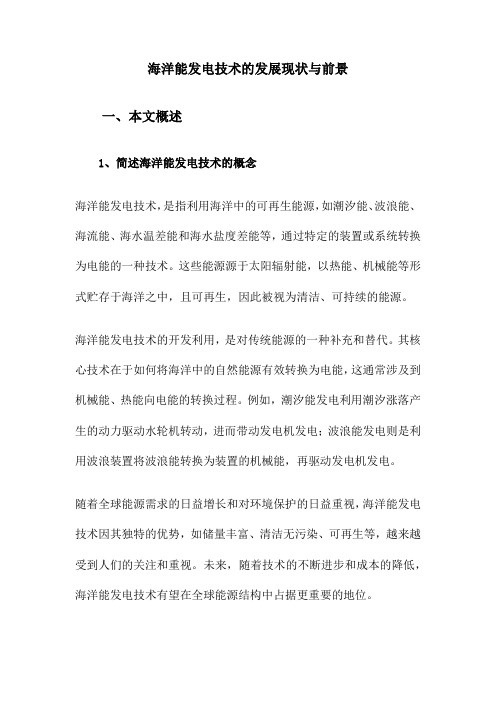
海洋能发电技术的发展现状与前景一、本文概述1、简述海洋能发电技术的概念海洋能发电技术,是指利用海洋中的可再生能源,如潮汐能、波浪能、海流能、海水温差能和海水盐度差能等,通过特定的装置或系统转换为电能的一种技术。
这些能源源于太阳辐射能,以热能、机械能等形式贮存于海洋之中,且可再生,因此被视为清洁、可持续的能源。
海洋能发电技术的开发利用,是对传统能源的一种补充和替代。
其核心技术在于如何将海洋中的自然能源有效转换为电能,这通常涉及到机械能、热能向电能的转换过程。
例如,潮汐能发电利用潮汐涨落产生的动力驱动水轮机转动,进而带动发电机发电;波浪能发电则是利用波浪装置将波浪能转换为装置的机械能,再驱动发电机发电。
随着全球能源需求的日益增长和对环境保护的日益重视,海洋能发电技术因其独特的优势,如储量丰富、清洁无污染、可再生等,越来越受到人们的关注和重视。
未来,随着技术的不断进步和成本的降低,海洋能发电技术有望在全球能源结构中占据更重要的地位。
2、阐述海洋能在全球能源结构中的重要性和意义在全球能源结构中,海洋能作为一种清洁、可再生的能源,具有极高的重要性和意义。
随着全球气候变化和环境问题日益严重,传统化石能源的消耗不仅加剧了温室气体的排放,也引发了资源枯竭的担忧。
因此,寻找可持续、环保的替代能源已成为全球共识。
海洋能,包括潮汐能、波浪能、海流能、海水温差能和海水盐差能等多种形式,是地球上最为丰富的能源之一。
它不受地理位置、天气条件等因素的限制,分布广泛且稳定可靠。
更重要的是,海洋能的开发利用几乎不产生污染物和温室气体,对环境的破坏极小,符合可持续发展的要求。
从全球能源战略的角度来看,海洋能的发展对于优化能源结构、保障能源安全具有重要意义。
随着技术的不断进步和成本的降低,海洋能发电在全球能源供应中的比重有望逐渐提升,成为未来能源体系的重要组成部分。
海洋能的开发利用还能带动相关产业的发展,创造就业机会,促进经济增长。
海流能发电技术的前沿研究与创新
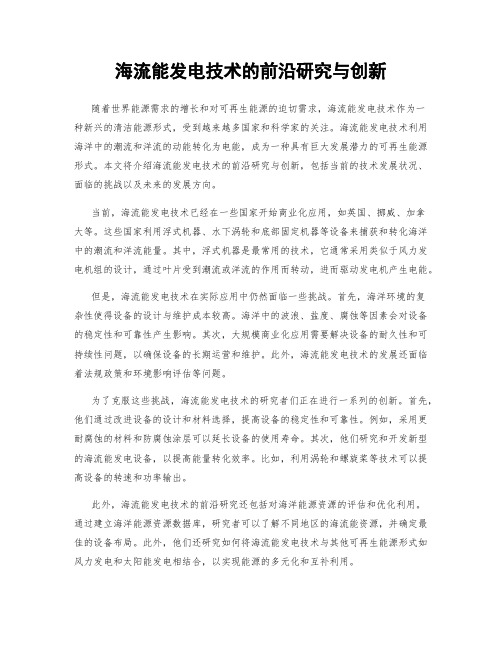
海流能发电技术的前沿研究与创新随着世界能源需求的增长和对可再生能源的迫切需求,海流能发电技术作为一种新兴的清洁能源形式,受到越来越多国家和科学家的关注。
海流能发电技术利用海洋中的潮流和洋流的动能转化为电能,成为一种具有巨大发展潜力的可再生能源形式。
本文将介绍海流能发电技术的前沿研究与创新,包括当前的技术发展状况、面临的挑战以及未来的发展方向。
当前,海流能发电技术已经在一些国家开始商业化应用,如英国、挪威、加拿大等。
这些国家利用浮式机器、水下涡轮和底部固定机器等设备来捕获和转化海洋中的潮流和洋流能量。
其中,浮式机器是最常用的技术,它通常采用类似于风力发电机组的设计,通过叶片受到潮流或洋流的作用而转动,进而驱动发电机产生电能。
但是,海流能发电技术在实际应用中仍然面临一些挑战。
首先,海洋环境的复杂性使得设备的设计与维护成本较高。
海洋中的波浪、盐度、腐蚀等因素会对设备的稳定性和可靠性产生影响。
其次,大规模商业化应用需要解决设备的耐久性和可持续性问题,以确保设备的长期运营和维护。
此外,海流能发电技术的发展还面临着法规政策和环境影响评估等问题。
为了克服这些挑战,海流能发电技术的研究者们正在进行一系列的创新。
首先,他们通过改进设备的设计和材料选择,提高设备的稳定性和可靠性。
例如,采用更耐腐蚀的材料和防腐蚀涂层可以延长设备的使用寿命。
其次,他们研究和开发新型的海流能发电设备,以提高能量转化效率。
比如,利用涡轮和螺旋桨等技术可以提高设备的转速和功率输出。
此外,海流能发电技术的前沿研究还包括对海洋能源资源的评估和优化利用。
通过建立海洋能源资源数据库,研究者可以了解不同地区的海流能资源,并确定最佳的设备布局。
此外,他们还研究如何将海流能发电技术与其他可再生能源形式如风力发电和太阳能发电相结合,以实现能源的多元化和互补利用。
未来,海流能发电技术的发展方向主要包括提高设备的能量转换效率、降低成本,并实现大规模商业化应用。
海洋能发电技术的发展现状与前景

海洋能发电技术的发展现状与前景摘要: 海洋能是取之不尽、用之不竭的清洁能源。
海洋能多种多样, 主要包括波浪能、潮流能、潮汐能和温差能等。
利用海洋能发电能够改善能源结构和环境, 有利于海洋资源开发, 受到许多国家的重视。
文中对各种海洋能发电系统的主要技术原理、特点和技术现状作了综述和评价, 最后指出海洋能利用的意义和前景。
关键词: 海洋能波浪能潮流能潮汐能环境保护海洋能是指依附在海水中的能源。
海洋通过各种物理过程或化学过程接收、存储和散发能量, 这些能量以波浪、海流、潮汐、温差等形式存在于海洋之中。
海洋面积占地球总面积的71%, 到达地球的各种来自宇宙的能量, 大部分落在海洋上空和海水中,部分转化为各种形式的海洋能。
海洋能的大部分来自于太阳的辐射和月球的引力。
例如: 太阳辐射到地球表面的太阳能大部分被海水吸收, 使海洋表层水温升高, 形成深部海水与表层海水之间的温差, 因而形成由高温到低温的温差能;太阳能的不均匀分布导致地球上空气流运动, 进而在海面产生波浪运动, 形成波浪能;由地球之外其他星球( 主要由月球)的引力导致的海面升高形成位能, 称为潮汐能;由上述引力导致的海水流动( 其特征是在一日内发生的、有规则的双向流动) 的动能称为潮流能;非潮流的海流( 其特征是一日内不发生双向的流动) 的成因有受风驱动或海水自身密度差驱动等, 归根结蒂是由太阳能造成的, 其动能称为海流能。
海洋能是清洁的可再生能源, 开发和利用海洋能对缓解能源危机和环境污染问题具有重要的意义, 许多国家特别是海洋能资源丰富的国家, 大力鼓励海洋能发电技术的发展。
由于海洋能发电系统的运行环境恶劣, 与其他可再生能源发电系统, 如风电、光伏发电相比, 发展相对滞后, 但是随着相关技术的发展, 以及各国科技工作者的努力, 近年来, 海洋能发电技术取得了长足的进步, 陆续有试验电站进入商业化运行。
可以预见, 不远的将来, 随着海洋能发电技术日益成熟, 将会有越来越多的海洋能发电系统接入电网运行。
海洋能发电技术的现状与未来发展趋势研究
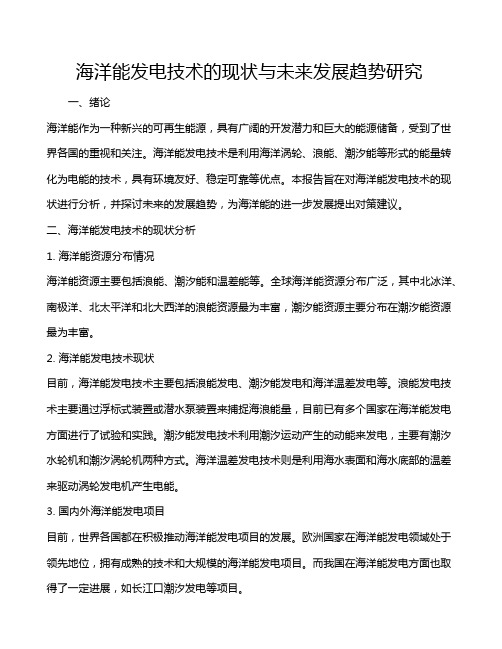
海洋能发电技术的现状与未来发展趋势研究一、绪论海洋能作为一种新兴的可再生能源,具有广阔的开发潜力和巨大的能源储备,受到了世界各国的重视和关注。
海洋能发电技术是利用海洋涡轮、浪能、潮汐能等形式的能量转化为电能的技术,具有环境友好、稳定可靠等优点。
本报告旨在对海洋能发电技术的现状进行分析,并探讨未来的发展趋势,为海洋能的进一步发展提出对策建议。
二、海洋能发电技术的现状分析1. 海洋能资源分布情况海洋能资源主要包括浪能、潮汐能和温差能等。
全球海洋能资源分布广泛,其中北冰洋、南极洋、北太平洋和北大西洋的浪能资源最为丰富,潮汐能资源主要分布在潮汐能资源最为丰富。
2. 海洋能发电技术现状目前,海洋能发电技术主要包括浪能发电、潮汐能发电和海洋温差发电等。
浪能发电技术主要通过浮标式装置或潜水泵装置来捕捉海浪能量,目前已有多个国家在海洋能发电方面进行了试验和实践。
潮汐能发电技术利用潮汐运动产生的动能来发电,主要有潮汐水轮机和潮汐涡轮机两种方式。
海洋温差发电技术则是利用海水表面和海水底部的温差来驱动涡轮发电机产生电能。
3. 国内外海洋能发电项目目前,世界各国都在积极推动海洋能发电项目的发展。
欧洲国家在海洋能发电领域处于领先地位,拥有成熟的技术和大规模的海洋能发电项目。
而我国在海洋能发电方面也取得了一定进展,如长江口潮汐发电等项目。
三、海洋能发电技术存在的问题1. 技术不成熟海洋能发电技术相对于其他能源技术而言仍处于发展阶段,存在着技术不成熟的问题。
特别是在海洋环境恶劣、设备耐久性等方面仍有待提高。
2. 经济问题海洋能发电项目的建设和运营成本较高,投资回报周期较长,需要支持和逐步完善的市场机制。
3. 环境影响海洋能发电项目在建设和运营过程中可能对海洋生态环境造成一定影响,如影响海洋生物迁徙和繁殖等。
四、海洋能发电技术发展的对策建议1. 加强技术研发应不断加大海洋能发电技术的研发力度,提升技术水平,解决技术难题,降低成本,提高效率。
海洋能发电技术的发展与应用前景

海洋能发电技术的发展与应用前景近年来,随着能源需求的增加和可再生能源的重要性逐渐凸显,海洋能发电技术成为人们关注的焦点。
海洋能发电是指利用潮汐、波浪、海流、海洋温差等海洋能源来产生电能的技术。
本文旨在探讨海洋能发电技术的发展现状以及其应用前景。
一、潮汐能发电技术的发展与应用前景潮汐能是指利用潮汐的上升和下降来获得能量的一种海洋能发电技术。
潮汐能发电技术经过多年的发展,已经具备可行性和商业化应用的潜力。
目前主流的潮汐能发电技术主要包括潮汐发电机和潮汐涡轮发电机。
潮汐发电机利用潮汐涨落的动能,通过潮汐水流的驱动产生电能。
同时,潮汐涡轮发电机则通过在水中设置涡轮装置,通过潮汐水流的流动来驱动涡轮并产生电能。
这些技术的发展不仅可以满足当地的电力需求,还可以为周边地区提供可再生的清洁能源。
未来,潮汐能发电技术有望在全球范围内得到更广泛的应用。
二、波浪能发电技术的发展与应用前景波浪能发电技术是一种利用海洋波浪动能来产生电能的技术,具有丰富的资源和较高的能量密度。
目前,主要的波浪能发电技术包括浮动式波浪能转换器和压力差波浪能转换器。
浮动式波浪能转换器通过将浮标与发电机连系,当波浪推动浮标上下浮动时,通过机械装置将波浪动能转化为电能。
而压力差波浪能转换器则通过利用波浪对设备的压力差来产生电能。
这些技术在海洋能发电领域具有重要的应用前景。
三、海流能发电技术的发展与应用前景海流能发电技术是指利用海洋中的水流动能转化为电能的技术。
海流能发电技术具有稳定性和预测性强的特点,成为可再生能源领域的热门技术。
目前,主要的海流能发电技术包括水轮发电机和垂直轴悬浮式涡轮发电机。
水轮发电机是利用水流对叶轮的冲击力来产生转动,从而驱动发电机产生电能。
垂直轴悬浮式涡轮发电机则是通过将多个轮叶组合成悬浮式结构,使其可以自动调整叶尖挂角,并将旋转的动能转化为电能。
这些技术在海洋能发电领域的应用前景可观。
四、海洋温差能发电技术的发展与应用前景海洋温差能发电技术是指利用海洋中不同温度层之间的温差来产生电能的技术。
海流能发电技术的现状与发展趋势
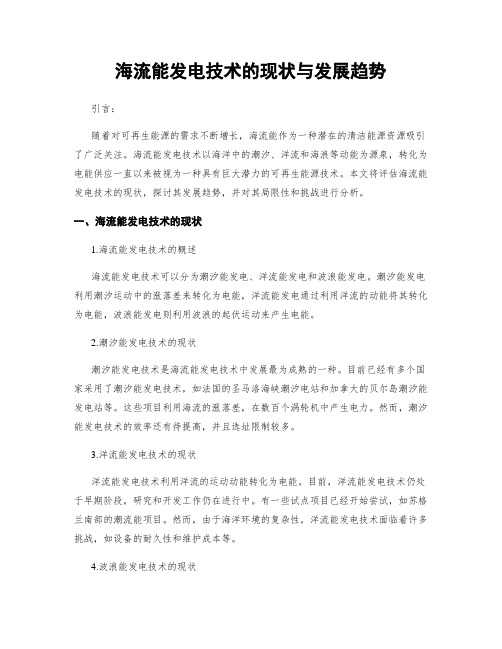
海流能发电技术的现状与发展趋势引言:随着对可再生能源的需求不断增长,海流能作为一种潜在的清洁能源资源吸引了广泛关注。
海流能发电技术以海洋中的潮汐、洋流和海浪等动能为源泉,转化为电能供应一直以来被视为一种具有巨大潜力的可再生能源技术。
本文将评估海流能发电技术的现状,探讨其发展趋势,并对其局限性和挑战进行分析。
一、海流能发电技术的现状1.海流能发电技术的概述海流能发电技术可以分为潮汐能发电、洋流能发电和波浪能发电。
潮汐能发电利用潮汐运动中的涨落差来转化为电能,洋流能发电通过利用洋流的动能将其转化为电能,波浪能发电则利用波浪的起伏运动来产生电能。
2.潮汐能发电技术的现状潮汐能发电技术是海流能发电技术中发展最为成熟的一种。
目前已经有多个国家采用了潮汐能发电技术,如法国的圣马洛海峡潮汐电站和加拿大的贝尔岛潮汐能发电站等。
这些项目利用海流的涨落差,在数百个涡轮机中产生电力。
然而,潮汐能发电技术的效率还有待提高,并且选址限制较多。
3.洋流能发电技术的现状洋流能发电技术利用洋流的运动动能转化为电能。
目前,洋流能发电技术仍处于早期阶段,研究和开发工作仍在进行中。
有一些试点项目已经开始尝试,如苏格兰南部的潮流能项目。
然而,由于海洋环境的复杂性,洋流能发电技术面临着许多挑战,如设备的耐久性和维护成本等。
4.波浪能发电技术的现状波浪能发电技术是海流能发电技术中相对较新的一种。
目前,波浪能发电技术还处于研究和实验阶段。
许多国家和地区正在探索波浪能发电技术的潜力,如葡萄牙和澳大利亚等。
波浪能发电技术的挑战主要包括海洋环境的压力和设备的稳定性。
二、海流能发电技术的发展趋势1.技术改进和成本降低随着对海流能发电技术的研究不断深入,技术改进将会带来效率的提高和成本的降低。
例如,利用先进的涡轮机设计来提高转化效率,采用先进材料和制造工艺来降低设备制造成本。
2.深水技术的发展海流能发电技术的研究正逐渐向深水区域扩展。
在深水区域,海流的速度更快,能量更丰富。
潮汐能发电的现状与未来发展
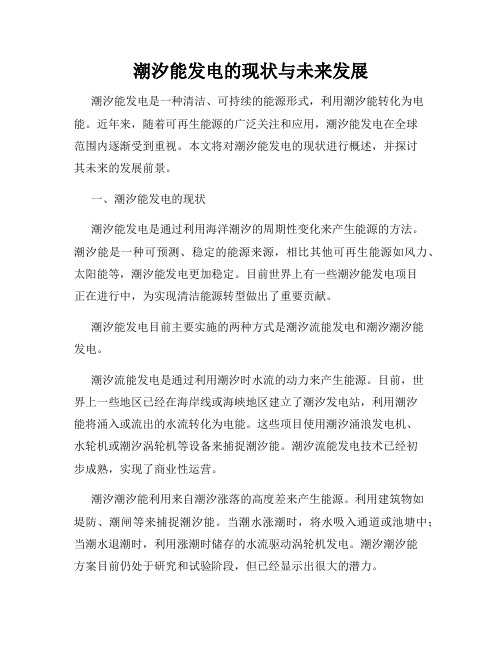
潮汐能发电的现状与未来发展潮汐能发电是一种清洁、可持续的能源形式,利用潮汐能转化为电能。
近年来,随着可再生能源的广泛关注和应用,潮汐能发电在全球范围内逐渐受到重视。
本文将对潮汐能发电的现状进行概述,并探讨其未来的发展前景。
一、潮汐能发电的现状潮汐能发电是通过利用海洋潮汐的周期性变化来产生能源的方法。
潮汐能是一种可预测、稳定的能源来源,相比其他可再生能源如风力、太阳能等,潮汐能发电更加稳定。
目前世界上有一些潮汐能发电项目正在进行中,为实现清洁能源转型做出了重要贡献。
潮汐能发电目前主要实施的两种方式是潮汐流能发电和潮汐潮汐能发电。
潮汐流能发电是通过利用潮汐时水流的动力来产生能源。
目前,世界上一些地区已经在海岸线或海峡地区建立了潮汐发电站,利用潮汐能将涌入或流出的水流转化为电能。
这些项目使用潮汐涌浪发电机、水轮机或潮汐涡轮机等设备来捕捉潮汐能。
潮汐流能发电技术已经初步成熟,实现了商业性运营。
潮汐潮汐能利用来自潮汐涨落的高度差来产生能源。
利用建筑物如堤防、潮闸等来捕捉潮汐能。
当潮水涨潮时,将水吸入通道或池塘中;当潮水退潮时,利用涨潮时储存的水流驱动涡轮机发电。
潮汐潮汐能方案目前仍处于研究和试验阶段,但已经显示出很大的潜力。
二、潮汐能发电的优势和挑战潮汐能发电相比传统能源具有一些显著的优势。
首先,潮汐能是一种清洁的能源形式,不会产生大气污染或温室气体排放。
它可以减少对传统能源如煤炭、石油等的依赖,有助于降低碳排放和缓解气候变化。
其次,潮汐能具有高度可预测性和稳定性。
由于潮汐的规律性和可预测性,潮汐能的发电效率更高,能够提供稳定的电力供应。
这对于能源供应的稳定性和网络平衡具有重要意义。
然而,潮汐能发电也面临一些挑战。
首先,潮汐能发电的建设成本较高。
由于需要建设海上设施,如大型涡轮机、浮标、电缆等,潮汐能发电的投资成本较高。
此外,维护和修复这些设施的费用也相当昂贵。
其次,潮汐能发电的地点选择限制较多。
为了获得良好的潮汐能资源,潮汐发电设施通常需要在海洋环境较为特殊的地区建设。
2024年潮汐发电设施市场分析现状

潮汐发电设施市场分析现状1. 引言潮汐发电作为一种新兴的可再生能源,受到越来越多的关注。
本文旨在对全球潮汐发电设施市场的分析现状进行研究,并探讨发展潮汐发电设施市场的挑战和机遇。
本文通过对目前市场规模、地理分布、技术发展和政策环境等方面的概述,揭示潮汐发电设施市场的现状。
2. 市场规模目前全球潮汐发电设施市场还处于初级阶段,市场规模相对较小。
据统计,截至2020年,全球潮汐发电设施的装机容量约为XX MW。
其中,英国、法国和韩国等国家是全球潮汐发电设施市场的主要推动力。
3. 地理分布目前,全球潮汐发电设施主要集中在欧洲和亚洲地区。
英国是全球最大的潮汐发电设施市场,其拥有多个潮汐能发电项目,如康沃尔潮汐能发电站和斯巴恩西潮汐能发电站。
除英国外,法国、韩国、加拿大和中国等国家也在积极发展潮汐发电设施市场。
4. 技术发展潮汐发电设施的技术发展也在不断进步。
目前主要的潮汐发电设施技术包括潮汐涡轮、水箱式潮汐能发电技术和潮流能发电技术等。
这些技术在改善潮汐发电设施的效率和可靠性方面发挥了重要作用,推动了市场的发展。
5. 政策环境政府的政策支持对潮汐发电设施市场的发展起到了积极的促进作用。
许多国家出台了相应的政策和法规,为潮汐发电设施提供了优惠的政策环境。
例如,英国政府设立了潮汐能源供应链加速器项目,韩国政府制定了潮汐发电设施建设的规划和政策,加速了潮汐发电设施市场的发展。
6. 挑战和机遇尽管潮汐发电设施市场发展潜力巨大,但仍面临着一些挑战。
首先,高昂的建设和维护成本限制了市场的扩展。
其次,技术上的限制和环境的不稳定性也是发展的障碍。
然而,随着技术的不断进步和政策的支持,潮汐发电设施市场仍然具有巨大的机遇。
发展潮汐发电设施有助于减少对传统能源的依赖,推进能源转型和环保事业的发展。
7. 结论综上所述,全球潮汐发电设施市场目前正在蓬勃发展,但市场规模相对较小。
英国、法国和韩国等国家是潮汐发电设施市场的主要推动力。
潮汐能发电技术的现状与发展趋势
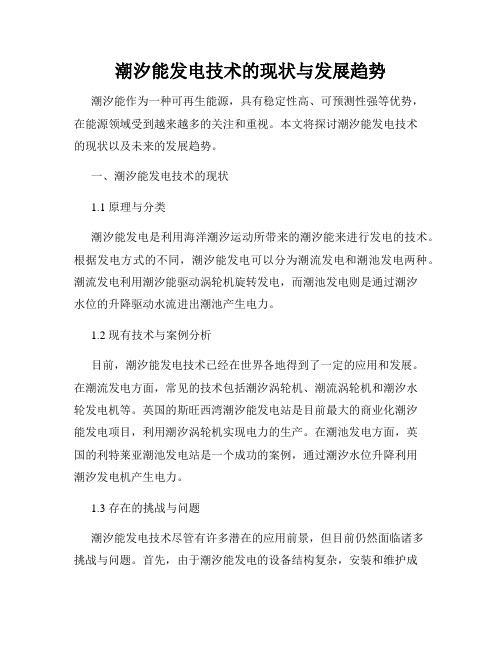
潮汐能发电技术的现状与发展趋势潮汐能作为一种可再生能源,具有稳定性高、可预测性强等优势,在能源领域受到越来越多的关注和重视。
本文将探讨潮汐能发电技术的现状以及未来的发展趋势。
一、潮汐能发电技术的现状1.1 原理与分类潮汐能发电是利用海洋潮汐运动所带来的潮汐能来进行发电的技术。
根据发电方式的不同,潮汐能发电可以分为潮流发电和潮池发电两种。
潮流发电利用潮汐能驱动涡轮机旋转发电,而潮池发电则是通过潮汐水位的升降驱动水流进出潮池产生电力。
1.2 现有技术与案例分析目前,潮汐能发电技术已经在世界各地得到了一定的应用和发展。
在潮流发电方面,常见的技术包括潮汐涡轮机、潮流涡轮机和潮汐水轮发电机等。
英国的斯旺西湾潮汐能发电站是目前最大的商业化潮汐能发电项目,利用潮汐涡轮机实现电力的生产。
在潮池发电方面,英国的利特莱亚潮池发电站是一个成功的案例,通过潮汐水位升降利用潮汐发电机产生电力。
1.3 存在的挑战与问题潮汐能发电技术尽管有许多潜在的应用前景,但目前仍然面临诸多挑战与问题。
首先,由于潮汐能发电的设备结构复杂,安装和维护成本较高,导致这一技术的经济性较差。
其次,潮汐能发电站的建设需要找到适合的潮汐能资源,而这样的资源并不是每个地区都能够轻易找到。
此外,潮汐能发电技术还需要解决对海洋生态环境的影响以及与渔业活动的冲突等问题。
二、潮汐能发电技术的发展趋势2.1 技术进步与成本降低随着科技的不断进步,潮汐能发电技术也在不断改进和创新。
新材料的应用、设备结构的优化以及工艺流程的改进等,都有助于提升潮汐能发电技术的效率和经济性。
预计随着关键技术的突破,潮汐能发电的成本将逐渐下降,更多地被应用于实际生产中。
2.2 多能源协同发展潮汐能作为清洁能源的一种,与其他可再生能源如风能、太阳能等相辅相成。
未来,将会出现风潮混合发电、海陆潮汐能混合发电等多能源协同发展的趋势,以优化能源结构和提高能源利用效率。
2.3 构筑海上综合利用平台随着资源的日益紧缺和环境保护意识的提高,未来的潮汐能发电将不仅仅局限于发电功能,还将构筑起海上综合利用的平台。
海洋能利用技术的现状与挑战
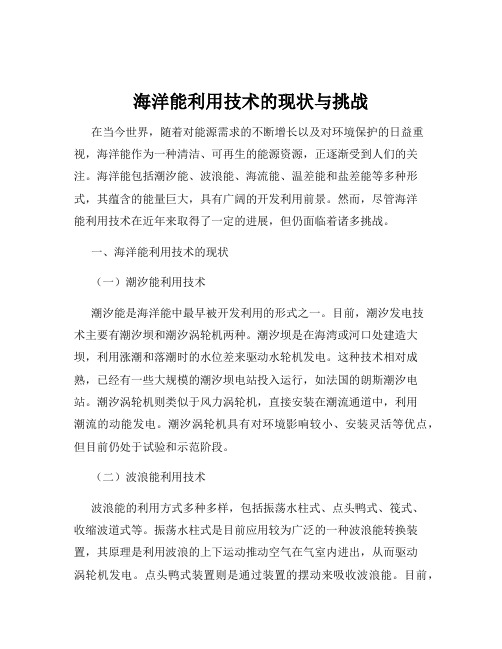
海洋能利用技术的现状与挑战在当今世界,随着对能源需求的不断增长以及对环境保护的日益重视,海洋能作为一种清洁、可再生的能源资源,正逐渐受到人们的关注。
海洋能包括潮汐能、波浪能、海流能、温差能和盐差能等多种形式,其蕴含的能量巨大,具有广阔的开发利用前景。
然而,尽管海洋能利用技术在近年来取得了一定的进展,但仍面临着诸多挑战。
一、海洋能利用技术的现状(一)潮汐能利用技术潮汐能是海洋能中最早被开发利用的形式之一。
目前,潮汐发电技术主要有潮汐坝和潮汐涡轮机两种。
潮汐坝是在海湾或河口处建造大坝,利用涨潮和落潮时的水位差来驱动水轮机发电。
这种技术相对成熟,已经有一些大规模的潮汐坝电站投入运行,如法国的朗斯潮汐电站。
潮汐涡轮机则类似于风力涡轮机,直接安装在潮流通道中,利用潮流的动能发电。
潮汐涡轮机具有对环境影响较小、安装灵活等优点,但目前仍处于试验和示范阶段。
(二)波浪能利用技术波浪能的利用方式多种多样,包括振荡水柱式、点头鸭式、筏式、收缩波道式等。
振荡水柱式是目前应用较为广泛的一种波浪能转换装置,其原理是利用波浪的上下运动推动空气在气室内进出,从而驱动涡轮机发电。
点头鸭式装置则是通过装置的摆动来吸收波浪能。
目前,波浪能发电技术仍面临着能量转换效率低、设备可靠性差、成本高等问题,但一些示范项目已经取得了一定的成果,如英国的 Pelamis 波浪能发电装置。
(三)海流能利用技术海流能的利用主要是通过安装海流涡轮机来实现。
海流涡轮机的工作原理与风力涡轮机类似,但由于海流的流速相对较低且较为稳定,因此海流涡轮机的设计和制造需要考虑更多的因素,如海洋环境的腐蚀性、生物附着等。
目前,海流能发电技术仍处于研发和试验阶段,尚未实现大规模商业化应用。
(四)温差能利用技术温差能是利用海洋表层和深层之间的温度差来驱动热机发电。
温差能发电系统通常包括蒸发器、冷凝器、涡轮机和工质等部分。
目前,温差能发电技术的效率较低,成本较高,还需要进一步的研究和改进。
海洋潮汐能发电技术及应用前景分析
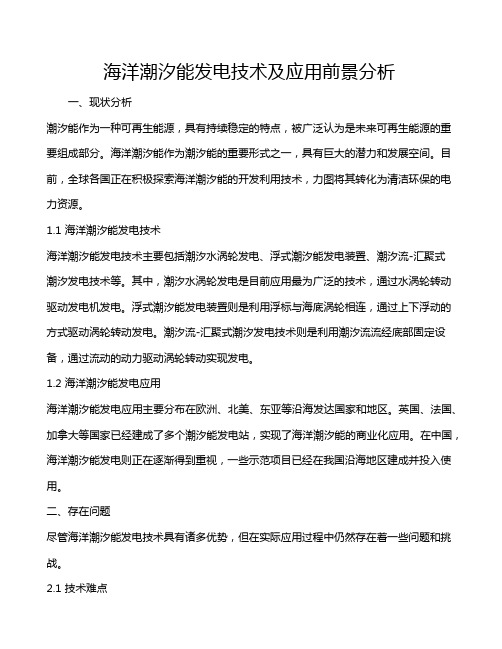
海洋潮汐能发电技术及应用前景分析一、现状分析潮汐能作为一种可再生能源,具有持续稳定的特点,被广泛认为是未来可再生能源的重要组成部分。
海洋潮汐能作为潮汐能的重要形式之一,具有巨大的潜力和发展空间。
目前,全球各国正在积极探索海洋潮汐能的开发利用技术,力图将其转化为清洁环保的电力资源。
1.1 海洋潮汐能发电技术海洋潮汐能发电技术主要包括潮汐水涡轮发电、浮式潮汐能发电装置、潮汐流-汇聚式潮汐发电技术等。
其中,潮汐水涡轮发电是目前应用最为广泛的技术,通过水涡轮转动驱动发电机发电。
浮式潮汐能发电装置则是利用浮标与海底涡轮相连,通过上下浮动的方式驱动涡轮转动发电。
潮汐流-汇聚式潮汐发电技术则是利用潮汐流流经底部固定设备,通过流动的动力驱动涡轮转动实现发电。
1.2 海洋潮汐能发电应用海洋潮汐能发电应用主要分布在欧洲、北美、东亚等沿海发达国家和地区。
英国、法国、加拿大等国家已经建成了多个潮汐能发电站,实现了海洋潮汐能的商业化应用。
在中国,海洋潮汐能发电则正在逐渐得到重视,一些示范项目已经在我国沿海地区建成并投入使用。
二、存在问题尽管海洋潮汐能发电技术具有诸多优势,但在实际应用过程中仍然存在着一些问题和挑战。
2.1 技术难点海洋潮汐能发电技术仍然面临着诸多技术难题,如潮汐能发电设备稳定性、运行成本高昂、维护保养困难等。
尤其是对于海洋环境苛刻的特点,需要设备具备强大的耐久性和适应性。
2.2 资金投入海洋潮汐能发电项目需要较大的资金投入,包括设备采购、建设施工、维护运营等方面的成本。
由于潮汐能发电尚处于发展初期,投资回报周期相对较长,需要吸引更多资金和资源的支持。
2.3 法律海洋潮汐能发电涉及到海洋资源开发利用和环境保护等方面的法律问题。
不同国家对于海洋潮汐能的法规有所不同,导致了项目开发和商业化进程受到一定影响。
三、对策建议为了促进海洋潮汐能发电技术的健康发展,我们提出以下对策建议:3.1 加强技术研发应加大对海洋潮汐能发电技术的研发投入,提高技术水平和设备性能,降低成本和提高效率,增强设备的可靠性和稳定性。
2023年海洋能发电行业市场分析现状

2023年海洋能发电行业市场分析现状海洋能发电是利用海洋能源转换成电能的一种可再生能源发电方式,包括潮汐能、波浪能、海流能和温差能。
它具有巨大的潜力,被认为是解决能源问题和实现可持续发展的重要手段。
随着全球对可再生能源的需求增加,并且对传统能源的依赖度逐渐减小,海洋能发电市场呈现出日益繁荣的趋势。
首先,海洋能发电行业的市场规模不断扩大。
根据国际能源机构的数据,截至2021年底,全球已建成的海洋能发电项目总装机容量已超过1GW。
早期的项目主要集中在欧洲,尤其是英国和挪威等国家。
随着技术的不断进步和成本的逐渐降低,越来越多的国家开始关注海洋能发电,并且加大投资力度,推动项目的开展。
预计到2030年,全球海洋能发电的装机容量有望超过10GW。
其次,海洋能发电技术不断创新。
尽管海洋能发电存在一些技术难题,如设备的耐久性、维护成本较高等问题,但是随着科技的进步,这些问题正在逐步得到解决。
目前,潮汐能和波浪能是最成熟的海洋能发电技术,已经进入商业化应用阶段。
同时,一些新兴技术如海流能和温差能也呈现出良好的发展趋势。
例如,挪威的海流能发电装置SeaTwirl已经开始商业化运营,并且在未来几年计划多建几个项目。
这些技术的不断创新和突破将推动海洋能发电行业的快速发展。
再次,政府政策的支持是推动海洋能发电市场发展的重要因素。
各国政府纷纷出台政策和法规,以鼓励和支持海洋能发电项目的建设。
例如,欧洲联盟制定了一系列法规,要求成员国增加可再生能源的比例,并且鼓励海洋能发电的发展。
此外,一些国家还提供了政府拨款和补贴,以减轻项目建设和运营的经济压力。
这些政策的出台为海洋能发电行业提供了良好的市场环境,吸引了更多的投资者和企业入场。
最后,海洋能发电市场面临一些挑战。
对海洋环境的影响是其中之一。
海洋能发电设备的部署和运营可能对海洋生物和生态环境造成一定的影响,尤其是对一些敏感生态系统。
因此,在开展海洋能发电项目时,需要进行充分的环境评估和监测,并采取相应的保护措施。
2024年海洋能发电市场分析现状
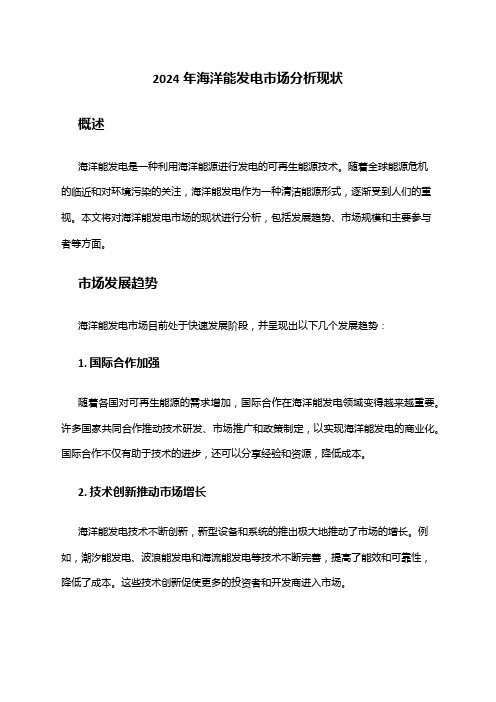
2024年海洋能发电市场分析现状概述海洋能发电是一种利用海洋能源进行发电的可再生能源技术。
随着全球能源危机的临近和对环境污染的关注,海洋能发电作为一种清洁能源形式,逐渐受到人们的重视。
本文将对海洋能发电市场的现状进行分析,包括发展趋势、市场规模和主要参与者等方面。
市场发展趋势海洋能发电市场目前处于快速发展阶段,并呈现出以下几个发展趋势:1. 国际合作加强随着各国对可再生能源的需求增加,国际合作在海洋能发电领域变得越来越重要。
许多国家共同合作推动技术研发、市场推广和政策制定,以实现海洋能发电的商业化。
国际合作不仅有助于技术的进步,还可以分享经验和资源,降低成本。
2. 技术创新推动市场增长海洋能发电技术不断创新,新型设备和系统的推出极大地推动了市场的增长。
例如,潮汐能发电、波浪能发电和海流能发电等技术不断完善,提高了能效和可靠性,降低了成本。
这些技术创新促使更多的投资者和开发商进入市场。
3. 政府扶持政策的增加随着环境保护和能源转型的需求增加,许多国家开始出台扶持政策来推动海洋能发电的发展。
政府补贴、税收减免和优惠政策等鼓励措施吸引了更多的投资者进入市场。
政府的支持将进一步推动市场的发展和壮大。
市场规模目前海洋能发电市场规模不断扩大,预计在未来几年将保持稳定增长。
以下是一些市场规模的关键指标:•全球装机容量增长:根据市场研究报告,截至2020年,全球海洋能发电装机容量已达到XX GW,预计到2030年将增长至XX GW。
•市场价值增长:海洋能发电市场的价值也在不断增长,预计到2025年将达到XX亿美元。
•区域市场分布:目前,欧洲地区是全球海洋能发电市场的主要消费地区,其占据了XX%的市场份额。
亚太地区和北美地区也在快速发展,预计未来几年将成为重要的市场。
主要参与者海洋能发电市场涉及多个参与者,包括早期创新企业、设备制造商和能源开发公司等。
以下是一些主要的参与者:1.早期创新企业:许多早期创新企业致力于海洋能发电技术的研发和商业化。
海洋能发电技术的现状与未来发展

海洋能发电技术的现状与未来发展在全球能源需求不断增长和对清洁能源的迫切追求下,海洋能作为一种丰富且可持续的能源资源,逐渐成为人们关注的焦点。
海洋能发电技术的研究与开发,不仅为解决能源危机提供了新的途径,也为保护海洋生态环境和实现可持续发展带来了新的希望。
海洋能主要包括潮汐能、波浪能、海流能、温差能和盐差能等多种形式。
每种形式都具有独特的特点和潜力,但也面临着不同的技术挑战和发展障碍。
潮汐能是目前海洋能中发展较为成熟的一种。
其原理是利用潮汐的涨落产生的势能来驱动水轮机发电。
世界上已经建成了一些潮汐能发电站,如法国的朗斯潮汐电站,它是世界上最大的潮汐能发电站之一。
潮汐能发电具有可预测性强、能量密度较高等优点,但也存在着建站选址受限、建设成本高昂以及对海洋生态环境可能产生一定影响等问题。
波浪能的开发利用则相对较为复杂。
波浪能的能量密度较高,但具有不稳定性和随机性。
目前,波浪能发电技术主要有振荡水柱式、点头鸭式、筏式等。
然而,这些技术在能量转换效率、设备可靠性和成本方面仍有待进一步提高。
尽管如此,一些小规模的波浪能发电装置已经在实验和示范阶段取得了一定的成果。
海流能是指海洋中由于海水流动而产生的能量。
海流能发电装置通常类似于风力发电机,但需要适应海洋环境的特殊要求,如防腐、抗冲击等。
目前,海流能发电技术仍处于研究和试验阶段,尚未实现大规模商业化应用。
温差能是利用海洋表层温暖海水和深层寒冷海水之间的温度差来驱动热机发电。
这种能源形式具有巨大的潜力,但技术难度极大,主要包括热交换效率低、设备成本高以及海洋环境的复杂性等问题。
盐差能则是利用海水和淡水之间的盐度差产生渗透压来发电。
虽然盐差能的理论能量密度较高,但目前仍处于实验室研究阶段,距离实际应用还有很长的路要走。
在海洋能发电技术的发展现状方面,虽然已经取得了一定的进展,但仍然面临着诸多挑战。
技术方面,能量转换效率低、设备可靠性差、成本高昂等问题仍然制约着海洋能的大规模开发利用。
2024年海洋能发电市场前景分析

2024年海洋能发电市场前景分析摘要本文对海洋能发电市场的前景进行分析。
通过对海洋能发电技术的发展现状和前景展望进行探讨,结合政府支持政策和市场需求,以及市场竞争状况进行综合分析,认为海洋能发电市场具有广阔的发展前景。
然而,面临的挑战也不容忽视,包括技术成本高、环境影响和政策支持等方面。
因此,为了实现海洋能发电市场的可持续发展,需要进一步加大技术研发力度,加强产业协调合作,提升海洋能发电的经济和环境效益。
1. 引言随着全球对可再生能源的需求不断增加和对碳排放的限制,海洋能发电作为一种清洁能源形式,受到了越来越多的关注。
海洋能发电是利用海洋中存在的能量形式来产生电力的过程,包括浪能发电、潮汐能发电和海流能发电等。
与传统的能源形式相比,海洋能发电具有丰富的资源、可再生性强、碳排放少等优势,被认为是未来能源发展的重要方向之一。
2. 发展现状与趋势目前,海洋能发电技术已经取得了一些重要的突破和进展。
浪能发电技术通过利用海浪的动能产生电力,可以在海岸线附近或海上安装浮标、浮筒等设备进行发电。
潮汐能发电则是利用潮汐涨落形成的潮流来推动涡轮机产生电力。
海流能发电则是通过利用海洋中存在的流动能量来驱动涡轮机产生电力。
这些技术在不同的地理环境和气候条件下都具有一定的适用性。
未来海洋能发电技术的发展趋势主要包括:提高发电设备的转换效率、降低成本、增强设备的可靠性和稳定性、提高能源利用效率等。
随着技术的不断进步,海洋能发电的规模和产能都将得到进一步提升,成为可再生能源中的重要组成部分。
3. 市场需求与政策支持由于对能源安全和环境保护的要求增加,全球市场对可再生能源的需求不断增加。
海洋能发电作为可再生能源的重要组成部分,受到了政府和消费者的广泛关注和支持。
各国政府纷纷出台政策措施,支持海洋能发电的发展,包括给予财政补贴、提供土地和海域使用权等。
这些政策支持有助于推动海洋能发电市场的发展,并吸引了更多的投资者进入海洋能发电领域。
海流能发电对气候变化的适应性与缓解作用

海流能发电对气候变化的适应性与缓解作用随着全球气候变化的加剧和对可再生能源需求的增长,海流能发电引起了广泛的关注。
作为一种可持续、低碳的能源形式,海流能发电具有良好的适应性和缓解气候变化的潜力。
本文将探讨海流能发电的发展现状、其对气候变化的适应性以及缓解作用,并分析其未来的发展前景。
首先,海流能发电的适应性体现在几个方面。
首先,海流能发电的装置可以灵活地安装在各种类型的水域中,包括海洋和河流。
这意味着无论沿海地区还是内陆地区,都可以利用海流能发电。
其次,海流能发电技术相对成熟,且与风能和太阳能相比,其强度和可预测性较高。
这使得海流能发电在提供可靠的电力供应方面更具竞争力。
最后,海流能发电系统相对简单,容易维护,并且对环境的影响较小。
这些特点使得海流能发电成为适应不同环境条件的可再生能源选择。
其次,海流能发电对气候变化具有显著的缓解作用。
首先,利用海流能发电可以减少对传统化石燃料的依赖,进而减少温室气体的排放。
这有助于遏制全球气候变暖的趋势,减少极端天气事件的发生。
其次,与其他可再生能源相比,海流能发电的密度较大,能够提供更大的电力输出。
这意味着可以用海流能发电替代传统的发电方式,减少化石燃料的燃烧,进一步减少温室气体的排放。
此外,海流能发电还可以促进能源多样化,并减少对有限的自然资源的依赖。
这有助于缓解全球能源供应问题,并降低能源价格的波动。
然而,要实现海流能发电的广泛应用仍面临一些挑战。
首先,海流能发电技术仍处于相对早期的发展阶段,存在技术不成熟和高成本的问题。
目前,与风能和太阳能相比,海流能发电的成本较高,限制了其大规模应用。
此外,海上环境条件恶劣,海流也具有不确定性,这对海流能发电的设备和系统设计提出了更高的要求。
因此,需要进一步的研发和技术创新来降低成本并提高效率,使海流能发电成为一种更具竞争力的能源形式。
未来,海流能发电的发展前景可谓广阔。
随着技术的进步和成本的降低,海流能发电将成为可再生能源领域的重要组成部分。
- 1、下载文档前请自行甄别文档内容的完整性,平台不提供额外的编辑、内容补充、找答案等附加服务。
- 2、"仅部分预览"的文档,不可在线预览部分如存在完整性等问题,可反馈申请退款(可完整预览的文档不适用该条件!)。
- 3、如文档侵犯您的权益,请联系客服反馈,我们会尽快为您处理(人工客服工作时间:9:00-18:30)。
An Up-to-Date Review of Large Marine Tidal Current Turbine TechnologiesZhibin Zhou1,2,3, Franck Scuiller1, Jean FrédéricCharpentier11French Naval Academy, EA 3634 IRENav,Brest, FranceEmail: zhibin.zhou@ecole-navale.frMohamed Benbouzid2 and Tianhao Tang3 2University of Brest, EA 4325 LBMS, Brest, France 3 Shanghai Maritime University, Shanghai, ChinaEmail: Mohamed.Benbouzid@univ-brest.fr,thtang@Abstract—Owning to the predictability of tidal current resources, marine tidal current energy is considered to be a reliable and promising renewable power source for coastal areas or some remote islands. During the last 10 years, various original horizontal axis and vertical axis marine current turbines (MCT) have been developed around the world. Although various projects have been reported in the state-of-the-art research papers in recent years, many of these projects were only at the design stage when the papers were published. In fact, some projects do not have any further developments during the several years after the first reporting. In this paper, up-to-date information about large tidal turbine projects over 500 kW is focused. The newest achievements of these large tidal current turbine technologies are presented. These technologies represent the industrial solutions for several pre-commercial MCT farm projects in the coming years. This paper provides a useful background for researchers in the marine turbine energy domain.Keywords—Tidal current turbine, large machine, up-to-date review.I.I NTRODUCTIONOne of the main advantages of marine current energy is related to the predictability of the resource. The astronomic nature of tides is driven by the gravitational interaction of the Earth-Moon-Sun system and makes marine tidal currents highly predictable with 98% accuracy for decades [1]. There are basically two ways of generating electricity from marine tidal energies: either by building a tidal barrage across an estuary or a bay, or by extracting energy from free flowing tidal currents. The main drawback of the solution is that large barrage system would change the hydrology and may have negative impacts on the local ecosystem [2]. Therefore during the last few decades, developers have shifted towards technologies that capture the kinetic energy from tidal-driven marine currents. The exploitable marine current energy with present technologies is estimated about 75 GW in the world and 11 GW in Europe [3].In fact, various original horizontal axis and vertical axis marine current turbines (MCT) have been developed around the world in recent years [4-6]. The majority of MCT devices are horizontal axis turbines with rotation axis parallel to the current flow direction. The main disadvantages associated with vertical axis turbines are relative low self-starting capability, high torque fluctuations and generally lower efficiency than horizontal axis turbine design. Currently, only horizontal axis MCTs appear to be the most technologically and economically solution for large-scale marine current turbines with power capacity over 500 kW.Although various turbine projects have been reported in some state-of-the-art research papers, many of these projects were only at the design stage when the papers were published [4], [7]. However, some projects are abandoned or never have been built, for instance, the Lunar Energy Tidal turbine. And some projects do not have further developments during the several years after the first announcement, such as Atlantis Resource Nereus and Solon turbines. Therefore, an up-to-date review of industrialized turbine technologies is necessary.In this paper, up-to-date information and the newest achievements of industrialized large tidal current turbine technologies (over 500 kW) will be focused. In Section II, the pilot pre-commercial MCT farms information and the industrialized large turbine technologies are presented. The conclusion and perspective are then given In Section III.II.L ARGE M ARINE C URRENT T URBINE T ECHNOLOGIESSeveral horizontal axis turbine technologies are developed more than one or two generations and have been chosen by the industrial communities to realize pilot demonstrative MCT farms before the final commercial stage. These projects illustrate the up-to-date developments of large MCT technologies which will provide electricity to coastal or island areas in the coming years. Table I summarizes the main information about some of these pilot MCT farm projects and their planned/estimated operational dates. From this table, it can be seen that most of these turbine technologies have attended megawatt-level power capacity.A.OpenHydro Turbine TechnologyOpenHydro is an open-center turbine technology; a 250 kW prototype was installed and tested at European Marine Energy Center (EMEC) off Orkney islands in Scotland and was connected to the UK national grid in 2008. This turbine technology has been chosen by the French companies EDF and DCNS to build a demonstrative MCT farm off the coast of Paimpol-Bréhat in Brittany, France.This work is supported by Brest Métropole Océane (BMO) and the Shanghai Maritime University.TABLE I. P ILOT MCT F ARMS IN THE C OMING Y EARS [3],[8-10].Companies Location Turbine Name PitchableBladesTurbineNumberTotal Capacity(MW)OperationalYearDCNS, EDF Paimpol-Bréhat OpenHydro No 4 2 2014/2015MeyGen Pentland Firth(Scotland)HS1000 Yes6 6 2015/2016or AR1000 NoMCT, SiemensKyle Rhea(Scotland)SeaGen S Yes 4 8 2015 Anglesey (Wales) SeaGen S Yes 5 10 2015Andritz Hydro Hammerfest Sound of Islay(Scotland)HS1000 Yes 10 10 > 2015GDF Suez, Eole Generation Raz Blanchard Voith Hytide No 3~6 3~12 2016 Fromveur Sabella No > 4 > 4 2016The first 500 kW OpenHydro turbine (Fig. 1) was tested in September 2011 near Brest. This 850 tonnes turbine has a diameter of 16 m and is supposed to be installed at a depth of 35 meters. This technology uses multi-blades fixed between the open-center rim and the outside shell in a rim-driven configuration. The permanent synchronous generator is integrated into the outside rim shell. The planed MCT farm with 4 turbines is reported to be in operation in 2014 [10]. However, some delays in the final farm operation could still be envisaged.B.HS1000 and AR1000 Turbine TechnologiesThe 1MW pre-commercial turbine HS1000 (Fig. 2) was tested by Andritz Hydro Hammerfest (original Hammerfest Strøm) at EMEC tidal test site at the end of 2011. It started delivering energy to the grid in 2012. The HS1000 turbine is based on the technology of a smaller prototype HS300 (300kW, reported as E-Tide turbine project in [6-7]) which was installed in Norway and connected to the public grid in 2004. This megawatt-level HS1000 turbine technology is planed to be used in a 10 MW commercial array in the Sound of Islay on the west coast of Scotland; the tidal resource and seabed surveys are completed [13]. This technology is also reported to be chosen in the first phase of the MeyGen tidal current project in Inner Sound of the Pentland Firth [9].Another candidate for the MeyGen project is the AR1000 turbine (Fig. 3) technology developed by Atlantis Resources Corporation [14]. The Atlantis AR1000 turbine features fixed pitch configuration and is rated at 1 MW at 2.65 m/s current velocity. The AR1000 can be rotated in the slack period between tides using a yaw drive for optimally facing the tides. The first AR1000 was successfully deployed and tested at the EMEC facility during the summer of 2011. The AR1000 system is also scheduled to be installed on Daishan demonstration site in China during 2014. A larger turbine called AR1500 (1.5 MW at 3.0 m/s) is under development for future installation in the Pentland Firth in Scotland and the Bay of Fundy in Canada.Fig. 1. DCNS-OpenHydro turbine © [11].Fig. 2. Andritz Hydro Hammerfest HS1000 turbine © [12].C.SeaGen S Turbine TechnologyThe SeaGen S turbine (showed in Fig. 4) developed by Marine Current Turbine Ltd. (owned by Siemens since 2012) is a well-known system that can generate electricity from marine current energy. This technology has a twin axial-flow turbine supported on a structure with the ability to raise the moving components out of the water for maintenance [16]. It is the world first grid-connected megawatt-level MCT system. The 1.2 MW SeaGen S system (2×600 kW) was installed in Strangford Lough in Northern Ireland in 2008 and has generated 8 GWh electricity since the installation. During a strong spring tide, the SeaGen S system can deliver more than 20 MWh in a single day. It is reported that up-scaled SeaGen S systems with 20 meter rotor and 2 MW power rating will be installed in two commercial arrays in UK waters (as listed in Table 1) from 2015.D.Voith Hydro Turbine TechnologyFrench energy company GDF Suez has plans to install pilot tidal energy farms at Raz Blanchard off the coast of Lower Normandy and in the Fromveur passage off the coast of Finistère in Brittany. These two sites represent 80% of the marine current energy potential in France [17]. For the Raz Blanchard project, GDF Suez has recently confirmed to use Voith Hydro HyTide turbine and Alstom tidal turbine technology. The Voith Hydro turbine system (shown in Fig. 5) is developed by German hydropower equipment maker Voith Company. The first test turbine of 110 kW has been in operation near the South Korean island of Jindo since 2011. The up-scaled version of 1 MW turbine is now installed and tested at EMEC tidal test site.The Voith Hydro turbine adopts robust design: it uses fixed-pitch blades and permanent magnet synchronous generator to achieve compact structure. Specially designed symmetric blade profile can be operated for bidirectional tidal currents avoiding pitch and yaw requirements. The nacelle system uses seawater lubrication technology to avoid grease and seals for the bearings. The electrical machine is protected from corrosion and marine fouling by proven coatings and sacrificial anodes. The low-maintenance characteristics makes the estimated system lifetime up to 20 years [18]. The 1 MW turbine has a rotor diameter of 16 m and reaches the rated power at a current velocity of 2.9 m/s.E.Sabella Turbine TechnologyOne of the potential MCT applications is to provide electricity for remote islands not connected to the continental electric grid. As example, in the near future, several MCTs are planed to be installed in the Fromveur passage (near Brest) in France to supply part of the load demand of Ouessant Island. For the Fromveur project, the Sabella tidal turbine technology will be used [19]. The Sabella D10 turbines have a rotor diameter of 10 m and a power capacity of 0.5~1.1 MW for 3.0~4.0 m/s current velocities. Figure 6 illustrates the perspective Sabella turbine farm. The Sabella D10 is based on the first French marine current turbine Sabella D03 (3 m rotor diameter) which was tested at Odet estuary near Brest in 2008. The prototype D10 turbine is now completing the construction and is scheduled to be installed in the Fromveur passage at the end of 2014. Larger turbines D12 and D15 with power capacities of 1~2 MW are under design for future turbine farm applications [19-20].Fig. 3. Atlantis AR1000 turbine © [14].Fig. 4. SeaGen S turbine © [15].Fig. 5. Voith Hydro turbine © [18].Fig. 6. Sabella turbine farm illustration © [20].F.Alstom Tidal Turbine TechnologiesIn 2010, Alstom announced a 1 MW turbine project named Beluga 9 for deployment in Canada's Bay of Fundy in 2012 [21]. Beluga 9 was a joint project with Canadian company Clean Current. It was intended for very powerful currents (up to 4.5 m/s) and for sites with depths of 30 meters or more. However, with the termination of the licensing agreements with Clean Current at the end of 2012, there is no further news about this megawatt turbine project. Clean Current has decided to focus on river turbines and shallower water tidal turbines (< 20 meters). While Alstom’s intention is to pursue the larger utility scale opportunities [22].In 2013, Alstom successfully installed a 1 MW tidal current turbine at EMEC tidal test site after the acquisition of Tidal Generation Limited (TGL) [23-24]. Figure 7 shows the Alstom’s 1 MW tidal turbine system. This tidal turbine weighs 150 tonnes and has three pitchable blades, a rotor diameter of 18 m and a nacelle length of 22 m. A standard drive train and power electronics device is inside the nacelle. This turbine system can be installed in a water depth between 35 and 80 meters. It can generate electricity with a tidal current between 1 m/s and 3.4 m/s, and reaches the rated power for a tidal current speed of 2.7 m/s. This 1 MW Alstom tidal turbine is under extensive testing and analysis in different operational conditions off Orkney islands throughout 2013 over an 18 month period.Fig. 7. Alstom tidal turbine © [23].Although the Alstom’s 1 MW tidal current turbine seems similar to a standard wind turbine system (with three pitchable blades and gearbox-integrated drive train), this tidal turbine have some special characteristics. Its buoyancy enables the turbine to be easily installed and retrieved by using small vessels, thus reducing the installation and maintenance costs. It has an intelligent nacelle which can be rotated by the water thrusts to orientate the turbine system to face the tide direction; that enables the system to harness energy efficiently from both ebb and flood tidesIII.C ONCLUSIONS AND P ERSPECTIVESThe turbines presented above represent the newest achievements in the megawatt-level marine current turbine technologies. The comment point is that they are all horizontal axis turbine. And it should be noted that more than half of these turbine technologies adopt the fixed pitch solution for the blades.In addition to these industrialized large turbine technologies, there are other megawatt turbine projects which are under development. For example, the TidalStream Triton technology mounts several turbines on a semi-submersible buoying platform to achieve high power harness capacity. The 1/23rd scale and 1/10th scale turbines (Triton T6 and Triton T3) were successfully tested in 2009 and 2011 respectively [25]. The first full-scale version Triton T36 system (with 2.5 MW power rating) is planned to be built at the Fundy Ocean Research Center for Energy (FORCE) tidal test site in Nova Scotia, Canada.It should be noted that in FORCE tidal test site, there are also several megawatt-level current turbine plans which are strongly related to the turbine technologies presented in this paper. High tidal current speed (up to 5.5m/s) and Nova Scotia's feed-in-tariff make FORCE one of the most attractive and economic tidal sites in the world [26-27]. Siemens and Bluewater are jointly developing a 2 MW floating tidal current turbine, called SeaGen F, to be installed in Bay of Fundy and it will supply electricity for 1,800 Nova Scotia households. OpenHydro, the DCNS tidal subsidiary, will proceed with plans for a grid-connected 4 MW tidal array to be installed at FORCE in later 2015. This array will consist of two 2 MW turbines with 16 m rotor diameters.R EFERENCES[1]S. Benelghali, R. Balme, K. Le Saux, M. E. H. Benbouzid, J. F.Charpentier, and F. Hauville, “A simulation model for the evaluation ofthe electrical power potential harnessed by a marine current turbine”, IEEE Journal of Oceanic Engineering, vol. 32, n o4, pp.786-797, Oct.2007.[2]R. Pelc, R.M. Fujita, “Renewable energy from the ocean”,MarinePolicy, vol. 26, issue 6, pp.471-479, Nov. 2002.[3]H. Boye, E. Caquot, P. Clement et al., “Rapport de la mission d’étudesur les énergies marines renouvelables,” March 2013. (in French)[4] F.O. Rourke, F. Boyle, A. Reynolds, “Marine current energy devices:Current status and possible future applications in Ireland,” Renewableand Sustainable Energy Reviews, vol. 14, n°3, pp.1026-1036, Apr. 2010.[5] A.S. Bahaj, “Generating electricity from the oceans,” Renewable andSustainable Energy Review, vol. 15, n°7, pp.3399-3416, Sept. 2011. [6]J. Zhang, L. Moreau, M. Machmoum, and P.E. Guillerm, “State of theart in tidal current energy extracting,” in Proceedings of the 2014 IEEE ICGE, Sfax (Tunisia), pp. 1-7, March 2014.[7]S. Benelghali, M.E.H. Benbouzid and J. F. Charpentier, “Marine tidalcurrent electric power generation technology: State of the art and current status,” in Proceedings of the 2007 IEEE IEMDC, Antalya (Turkey), vol.2, pp. 1407-1412, May 2007.[8]http://www.global-et-local.eu/?Hydroliennes-les-industriels(last accessed August 2014)[9]/the-project/meygen-news/(last accessed August 2014)[10]/view/26574/gdf-suez-investigates-french-tidal-potential/ (last accessed August 2014) [11]/2011/11/14/worlds-largest-tidal-power-array-off-french-coast/ (last accessed August 2014)[12]/50635/andritz-back-in-action-at-emec/ (last accessedAugust 2014)[13]/ (last accessed August 2014)[14]/technology/ar-series.html (last accessedAugust 2014)[15]/ (last accessed August 2014)[16]/en/news_press/index/news_archive/seagen-tidal-currant-turbine-milestone-hat-trick.htm (last accessed August 2014) [17]/en/journalists/press-releases/gdf-suez-bolsters-plans-for-marine-current-power-france-signing-partnership-agreement-alstom/ (last accessed August 2014)[18]/en/products-services/hydro-power/ocean-energies/tidal-current-power-stations--591.html (last accessed August 2014)[19]http://www.sabella.fr/ (last accessed August 2014)[20]/7/17093+sabella-implante-la-premiere-hydrolienne-francaise-connectee-au-reseau+.html (last accessed August 2014)[21]/press-centre/2010/12/alstoms-ocean-energy-business-established-at-nantes/ (last accessed August 2014)[22]/news?page=1 (last accessed August 2014)[23]/blog/2013/01/alstom-completes-purchase-of-tidal-generation-ltd-from-rolls-royce/ (last accessed August 2014)[24]/blog/2013/03/1-mw-alstom-tidal-turbine-generates-grid-electricity-in-orkney-waters/(last accessed August 2014)[25]/index.html (last accessed August 2014)[26]/News/2014/04/04/siemens-bluewater-and-minas-install-floating-tidal-current-turbines-canadas-bay(last accessed August 2014)[27]/environmental-permitting/north-american-turbine-testing-picks-speed-regulatory-support-and-hydro-his(last accessed August 2014)。
